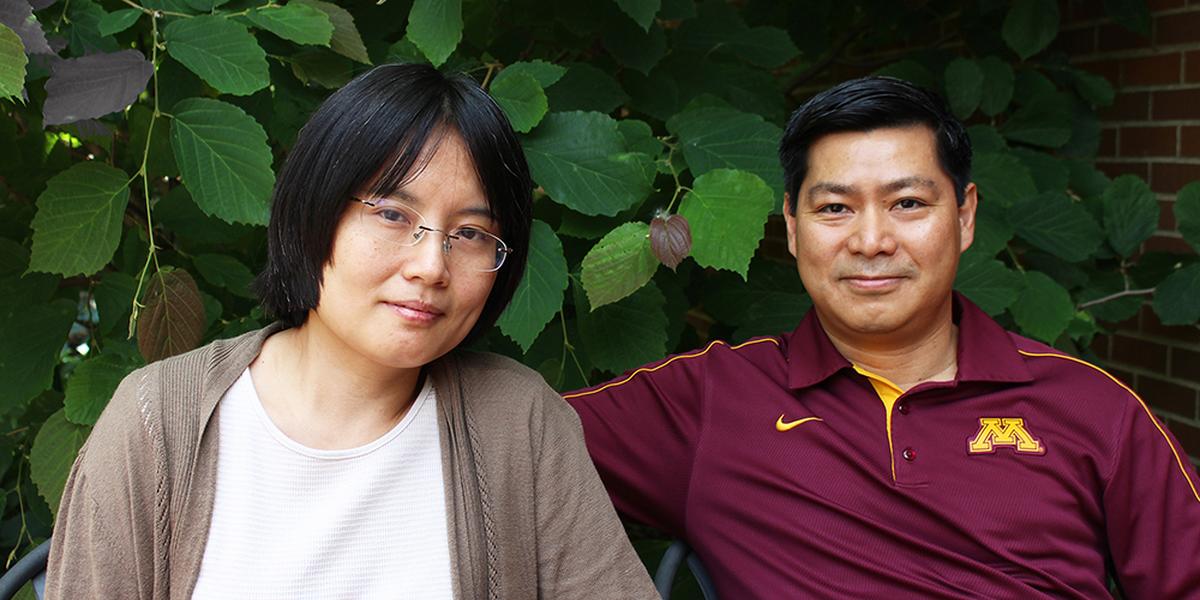Always a team
A CVM power couple tackles COVID-19 and life together

A CVM power couple tackles COVID-19 and life together
Yuying Liang (left) and Hinh Ly (right)
All photos in this story were taken prior to the COVID-19 outbreak.
When Yuying Liang, MS, PhD says, “As scientists, we accept that there may be diverse answers to the same questions and we accept differences in how scientists form opinions,” she’s not just talking about how she and her collaborator, Hinh Ly, MA, PhD, run their joint lab. She’s also talking about their marriage.
For many couples, the pandemic has increased time spent together and put vows to the test. But when it comes to partnering, Yuying Liang and Hinh Ly are a rock-solid team. Whether they’re in the lab developing therapies and treatments for COVID-19, or getting their twin boys out for a round of tennis to ward off cabin fever, the duo collaborates in and out of the lab.
But what’s their secret? “We have a lot of common interests but from different perspectives,” Liang says, “because we have had different training before.” Liang received her PhD in genetics while Ly’s is in microbiology and immunology. “New projects develop naturally out of the way we collaborate because our work styles complement each other. That’s important because we can’t be good at everything.” Liang and Ly agree: Liang handles key details and making things happen, while Ly keeps the bigger picture in mind, fostering brainstorming, managerial skills, entrepreneurship and collaboration.
“We always welcome new perspectives and new ways of thinking,” Ly says, “not just from each other but from our trainees as well.”
New projects develop naturally out of the way we collaborate because our work styles complement each other. That’s important because we can’t be good at everything.
Yuying Liang, MS, PhD
Scroll through below to learn more about what research the Ly-Liang lab is doing on SARS-CoV-2, the virus that causes COVID-19, with funding from OACA.
The duo met in 2000 while doing their postdoctoral training at the University of California-San Francisco. They worked in neighboring labs — he on human immunodeficiency virus (HIV), cancer, and aging, and she on Kaposi's sarcoma-associated herpesvirus. “We both had such a wonderful time there,” Ly says, “and eventually, we decided to get married before we moved to Atlanta to work as assistant professors at Emory University in 2003.”
In 2007, their twins, Darren and Derrick, were born. Five years later, the couple took jobs as professors in the Department of Veterinary and Biomedical Sciences at the University of Minnesota College of Veterinary Medicine. The public school system in the Twin Cities also motivated the couple to relocate to Minnesota.
“From a professional perspective, the U of M is also very comprehensive and has almost every discipline you can think of,” adds Liang. “We have developed many different collaborations both within the CVM and across campus. Our research has evolved very successfully and we have started some great collaborations on campus and even with local industry companies to develop our projects even further into applied and translational medicines to benefit humans, companion animals, and livestock.”
Ly smiles at Liang. “Good things really do come in pairs,” he says.
Good things really do come in pairs.
Hinh Ly, MA, PhD
If you are interested in supporting the Liang-Ly lab’s research on COVID-19, contact Bill Venne, director of development and alumni relations at the CVM, at venne025@umn.edu, or 612-625-8480. Or, click on the button below: